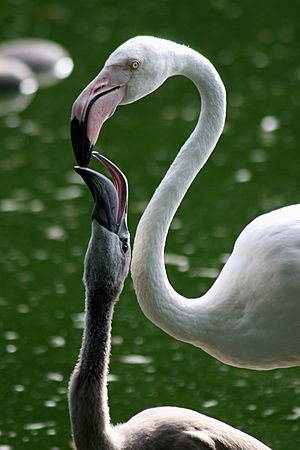Crop milk facts for kids
Crop milk is a special, milky substance that some parent birds make in their crop (a pouch in their throat). They feed this "milk" to their baby birds, called chicks, by regurgitating it. It's a bit like how mammals feed their young with milk, but bird crop milk is not actually milk from mammary glands.
This amazing way of feeding is found in all pigeons and doves, where it's often called pigeon milk. But pigeons aren't the only ones! Flamingos and even some penguins also produce crop milk to nourish their young. It's packed with nutrients to help chicks grow big and strong.
Contents
What is Crop Milk?
Crop milk is a thick, yellowish, and cheese-like substance. It's made up of cells that break away from the lining of the parent bird's crop. These cells are full of fat and protein, which are super important for fast-growing chicks. Unlike mammal milk, crop milk doesn't contain any carbohydrates like sugar.
How Birds Make Crop Milk
Birds don't have mammary glands like mammals do. Instead, their crop, which is usually used to store food, changes to produce this special milk. Hormones, especially one called Prolactin, tell the crop lining to start growing and producing these nutrient-rich cells. Both male and female parent birds can produce crop milk, which means both parents can help feed their babies.
Pigeon Milk Production
In pigeons, the crop lining gets thicker and starts to shed cells. These cells mix with water to form the milky substance. The parents then bring this up from their crop and feed it directly into the mouths of their hungry chicks. This process starts a few days before the eggs hatch and continues for several weeks after.
Flamingo Crop Milk
Flamingos also produce crop milk, but it's a bit different. Their crop milk is made in glands higher up in their digestive system, not just the crop itself. It's also very rich in fat and protein, and it even contains red and white blood cells. This gives it a reddish color. Parent flamingos can lose a lot of their own body weight and color while feeding their chicks because producing crop milk uses so much energy.
Penguin Crop Milk
Some penguins, like the Emperor Penguin, also produce a similar substance. When food is scarce, male emperor penguins can produce a fatty, protein-rich secretion from their esophagus (the tube connecting the throat to the stomach). This helps them feed their chick for a short time until the female returns with food from the ocean.
Why is Crop Milk Important?
Crop milk is vital for the survival of young birds that receive it. It provides all the nutrients they need in their first few weeks of life. Chicks grow incredibly fast on this diet. For example, pigeon chicks can double their weight in just a few days thanks to the rich crop milk.
Benefits for Chicks
- High Nutrition: It's packed with fats and proteins, which are essential for rapid growth and development.
- Easy to Digest: The liquid form makes it easy for tiny chicks to swallow and digest.
- Immunity: Crop milk can also contain antibodies from the parents, which helps protect the chicks from diseases.
- Survival in Harsh Environments: For birds like emperor penguins, it's a crucial way to keep chicks alive when food is hard to find.
Crop Milk vs. Mammal Milk
Even though it's called "milk," crop milk is quite different from the milk produced by mammals.
- Origin: Crop milk comes from the bird's crop or esophagus, while mammal milk comes from mammary glands.
- Composition: Crop milk is mostly fat and protein, with no sugar. Mammal milk contains fats, proteins, and sugars (lactose).
- Production: Bird crop milk is made of shed cells, while mammal milk is a secretion.
- Color: Pigeon crop milk is yellowish-white, while flamingo crop milk can be reddish. Mammal milk is typically white.
This unique feeding method shows how diverse and amazing the natural world is, with different animals finding incredible ways to care for their young.
See also
 In Spanish: Leche de buche para niños
In Spanish: Leche de buche para niños


